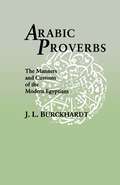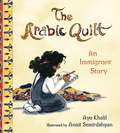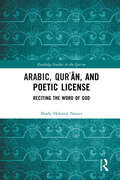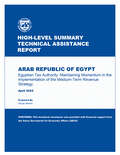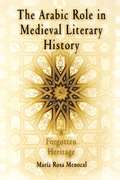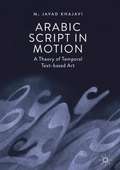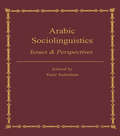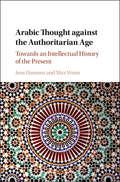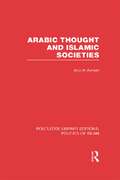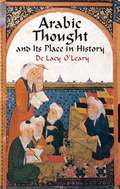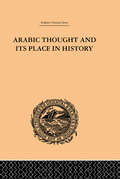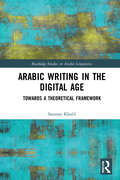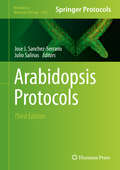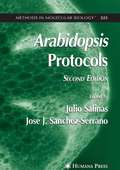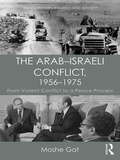- Table View
- List View
The Arabic Print Revolution
by Ami AyalonIn a brief historic moment, printing presses, publishing ventures, a periodical press, circulation networks, and a mass readership came into being all at once in the Middle East, where none had previously existed, with ramifications in every sphere of the community's life. Among other outcomes, this significant change facilitated the cultural and literary movement known as the Arab 'nahda' ('awakening'). Ayalon's book offers both students and scholars a critical inquiry into the formative phase of that shift in Arab societies. This comprehensive analysis explores the advent of printing and publishing; the formation of mass readership; and the creation of distribution channels, the vital and often overlooked nexus linking the former two processes. It considers questions of cultural and religious tradition, social norms and relations, and concepts of education, offering a unique presentation of the emerging print culture in the Middle East.
Arabic Proverbs: The Manners and Customs of the Modern Egyptians (Cambridge Library Collection - Travel, Middle East And Asia Minor Ser.)
by J. L. BurckhardtCompleted just before his death in 1817 by one of the foremost European pioneers in Arabic studies. Reprint with Introduction by C.E. Bosworth.
The Arabic Quilt: An Immigrant Story
by Aya KhalilKanzi’s family has moved from Egypt to America, and on her first day in a new school, what she wants more than anything is to fit in. Maybe that’s why she forgets to take the kofta sandwich her mother has made for her lunch, but that backfires when Mama shows up at school with the sandwich. Mama wears a hijab and calls her daughter Habibti (dear one). When she leaves, the teasing starts. <P><P> That night, Kanzi wraps herself in the beautiful Arabic quilt her teita (grandma) in Cairo gave her and writes a poem in Arabic about the quilt. Next day her teacher sees the poem and gets the entire class excited about creating a “quilt” (a paper collage) of student names in Arabic. In the end, Kanzi’s most treasured reminder of her old home provides a pathway for acceptance in her new one. <P><P> This authentic story with beautiful illustrations includes a glossary of Arabic words and a presentation of Arabic letters with their phonetic English equivalents. <P><P><i>Advisory: Bookshare has learned that this book offers only partial accessibility. We have kept it in the collection because it is useful for some of our members. Benetech is actively working on projects to improve accessibility issues such as these.</i>
Arabic, Qurʾān, and Poetic License: Reciting the Word of God (Routledge Studies in the Qur'an)
by null Shady Hekmat NasserThis book examines the similarities between the Qurʾān and ancient Arabic poetry, analyzed through the framework of Arabic grammar prior to their standardization and subsequent development into distinct genres.Of central relevance is the relationship between the Qurʾān and Arabic poetry, and how Muslim scholars defined this relationship based on a formulaic structural approach rather than a thematic and motif-oriented one. The book aims to reposition the so-called non-standard usages of Arabic vernaculars, non-canonical readings of the Qurʾān, and unusual grammatical structures in ancient poetry at the heart of the Arabic-Islamic tradition. The book deals with different theological, legal, and social controversies regarding the proper recitation of the Qurʾān and its individuation from poetry and other verbal arts. For the first time, this study offers a comprehensive categorization of unusual grammatical structures in both the Qurʾān and ancient Arabic poetry, which Arab grammarians classified as poetic license. The close affinity between the linguistic styles of the Qurʾān and ancient Arabic poetry suggests that the Qurʾān was a form of ancient Arabic poetry. To individuate the Qurʾān, Muslim scholars put in place various theological and legal restrictions for its proper recitation, the most important of which was tajwīd (Qurʾānic recitation).The book will interest students and scholars of Qurʾānic and Islamic studies, as well as those researching Arabic poetry and grammar.
Arabic Republic of Egypt: Egyptian Tax Authority: Maintaining Momentum in the Implementation of the Medium-Term Revenue Strategy (MTRS)
by De MetsA report from the International Monetary Fund.
The Arabic Role in Medieval Literary History
by Maria Rosa MenocalArabic culture was a central and shaping phenomenon in medieval Europe, yet its influence on medieval literature has been ignored or marginalized for the last two centuries. In this ground-breaking book, now returned to print with a new afterword by the author, María Rosa Menocal argues that major modifications of the medieval canon and its literary history are necessary.Menocal reviews the Arabic cultural presence in a variety of key settings, including the courts of William of Aquitaine and Frederick II, the universities in London, Paris, and Bologna, and Cluny under Peter the Venerable, and she examines how our perception of specific texts including the courtly love lyric and the works of Dante and Boccaccio would be altered by an acknowledgment of the Arabic cultural component.
Arabic Science Fiction (Studies In Global Science Fiction)
by Ian CampbellProvides a nuanced and comprehensive study of Arabic science fiction.<p><p> Contributes to postcolonial literary studies, genre studies and Arabic literature.<p> Extends research on global science fiction.<p>This book traces the roots of Arabic science fiction through classical and medieval Arabic literature, undertaking close readings of formative texts of Arabic science fiction via a critical framework developed from the work of Western critics of Western science fiction, Arab critics of Arabic science fiction and postcolonial theorists of literature. Ian Campbell investigates the ways in which Arabic science fiction engages with a theoretical concept he terms “double estrangement” wherein these texts provide social or political criticism through estrangement and simultaneously critique their own societies’ inability or refusal to engage in the sort of modernization that would lead the Arab world back to leadership in science and technology.
Arabic Script in Motion: A Theory Of Temporal Text-based Art
by M. Javad KhajaviThis book is a pioneering study of temporal typography and time-based calligraphic art written in the Arabic system of writing. Inspired by the innate qualities of Arabic script as well as certain practices in Islamic calligraphy and contemporary calligraphic art, the book devises five broad categories of temporal behaviors for Arabic characters in time-based media. It goes onto expand the vocabulary used to describe Arabic script’s appearance in time-based media and proposes a theory to help artists, practitioners, and theoreticians push the boundaries of temporal text-based art. Furthermore, it tackles questions of legibility and readability, and seeks to understand how temporality of Arabic text influences the creation of meaning. This book will therefore appeal not only to animators, designers, and artists, but also to commentators and scholars who deal with temporal text-based art written in Arabic script.
Arabic Sociolinguistics: Issues and Perspectives
by Yasir SuleimanA coherent and stimulating survey of current research.
Arabic Stories
by Hezi Brosh Lutfi MansurArabic Stories for Language Learners—a language learning experience for beginner to intermediate students. The traditional stories of a country are invaluable at providing insight into understanding the culture, history and language of a people. The sixty-six stories found in Arabic Stories for Language Learners present the vocabulary and grammar used everyday in Arabic-speaking countries. Pulled from a wide variety of sources that have been edited and simplified for learning purposes, these stories are presented in parallel Arabic and English, facilitating language learning in the classroom and via self-study. Each story is followed by a series of questions in Arabic and English to test comprehension and encourage discussion. Arabic Stories for Language Learners brings Arab culture to life in a colorful and immediate way. Regardless of whether or not you have a working knowledge of Arabic, this book gives readers a tantalizing introduction to the wisdom and humor of these ancient desert-dwelling peoples. An audio CD in Arabic and English helps students of Arabic improve their pronunciation and inflection, and immerses non-students into the uniquely Arabic storytelling style.
Arabic Stories for Language Learners
by Hezi Brosh Lutfi MansurArabic Stories for Language Learners--a language learning experience for beginner to intermediate students.The traditional stories of a country are invaluable at providing insight into understanding the culture, history and language of a people. The sixty-six stories found in Arabic Stories for Language Learners present the vocabulary and grammar used everyday in Arabic-speaking countries. Pulled from a wide variety of sources that have been edited and simplified for learning purposes, these stories are presented in parallel Arabic and English, facilitating language learning in the classroom and via self-study. Each story is followed by a series of questions in Arabic and English to test comprehension and encourage discussion.Arabic Stories for Language Learners brings Arab culture to life in a colorful and immediate way. Regardless of whether or not you have a working knowledge of Arabic, this book gives readers a tantalizing introduction to the wisdom and humor of these ancient desert-dwelling peoples. An audio CD in Arabic and English helps students of Arabic improve their pronunciation and inflection, and immerses non-students into the uniquely Arabic storytelling style.
Arabic Thought against the Authoritarian Age: Towards an Intellectual History of the Present
by Max Weiss Jens HanssenIn the wake of the Arab uprisings, the Middle East descended into a frenzy of political turmoil and unprecedented human tragedy which reinforced regrettable stereotypes about the moribund state of Arab intellectual and cultural life. This volume sheds important light on diverse facets of the post-war Arab world and its vibrant intellectual, literary and political history. Cutting-edge research is presented on such wide-ranging topics as poetry, intellectual history, political philosophy, and religious reform and cultural resilience all across the length and breadth of the Arab world, from Morocco to the Gulf States. This is an important statement of new directions in Middle East studies that challenges conventional thinking and has added relevance to the study of global intellectual history more broadly.
Arabic Thought and Islamic Societies (Routledge Library Editions: Politics of Islam)
by Aziz Al-AzmehThis is a study of the structure and composition of the official learning current in medieval Arabic culture. This comprises natural sciences both exoteric and esoteric (medicine, alchemy, astrology and others), traditional and religious sciences (such as theology, exegesis and grammar), philosophical sciences such as metaphysics and ethics, in addition to technical disciplines like political theory and medicine, and other fields of intellectual endeavour. The book identifies and develops a number of conceptual elements common to the various areas of official Arabic scientific discourse, and shows how these elements integrate these disparate sciences into an historical epistemic unity. The specific profile of each of these different sciences is described, in terms of its conceptual content, but especially with reference to its historical circumstances. These are seen to be embodied in a number of institutional supports, both intellectual and social: paradigms, schools of thought, institutions of learning, pedagogic techniques, and a body of professionals, all of which combine to form definite, albeit ever renewed, traditions of learning. Finally, an attempt is made to relate Arabic scientific knowledge in the Middle Ages to patterns of scientific and political authority. First published in 1986.
Arabic Thought and Its Place in History
by De Lacy O'LearyWell-documented study of the mutual influence of Arabic and Western worlds during the Middle Ages traces the transmission of Greek philosophy and science to the Islamic cultures. A fascinating portrait of medieval Muslim thought, it illustrates commonalities with Judaic and Christian teachings as well as points of divergence.
Arabic Thought and its Place in History
by De Lacy O'LearyFirst published in 2000. Routledge is an imprint of Taylor & Francis, an informa company.
Arabic Thought Beyond the Liberal Age
by Jens Hanssen Max WeissWhat is the relationship between thought and practice in the domains of language, literature and politics? Is thought the only standard by which to measure intellectual history? How did Arab intellectuals change and affect political, social, cultural and economic developments from the eighteenth to the twentieth centuries? This volume offers a fundamental overhaul and revival of modern Arab intellectual history. Using Hourani's Arabic Thought in the Liberal Age, 1798–1939 (Cambridge, 1962) as a starting point, it reassesses Arabic cultural production and political thought in the light of current scholarship and extends the analysis beyond Napoleon's invasion of Egypt and the outbreak of World War II. The chapters offer a mixture of broad-stroke history on the construction of 'the Muslim world', and the emergence of the rule of law and constitutionalism in the Ottoman empire, as well as case studies on individual Arab intellectuals that illuminate the transformation of modern Arabic thought.
Arabic Thought in the Liberal Age
by Albert HouraniArabic Thought in the Liberal Age is the most comprehensive study of the modernizing trend of political and social thought in the Arab Middle East. Albert Hourani studies the way in which ideas about politics and society changed during the nineteenth and the first half of the twentieth centuries, in response to the expanding influence of Europe. His main attention is given to the movement of ideas in Egypt and Lebanon. He shows how two streams of thought, the one aiming to restate the social principles of Islam, and the other to justify the separation of religion from politics, flowed into each other to create the Egyptian and Arab nationalisms of the present century. The last chapter of the book surveys the main tendencies of thought in the post-war years. Since its publication in 1962, this book has been regarded as a modern classic of interpretation. It was reissued by the Cambridge University Press in 1983 and has subsequently sold over 8000 copies.
Arabic Translation Across Discourses (Routledge Studies in Language and Identity)
by Said FaiqA rare contribution to global translation as a ‘cross-cultural-open-concept’, Arabic Translation Across Discourses provides explorations of Arabic translation as an instance of transcultural and translingual encounters (transculguaging). This book examines the application and interrogation of discourses of translation in the translation of discourses (religion, literature, media, politics, technology, community, audiovisual, and automated systems of communication for translation). The contributors provide insights into the concerns and debates of Arabic translation as a tradition with local, yet global dimensions of translation and intercultural studies. This volume will be of great interest to students and researchers of all translation studies, but will also provide a rich source for those studying and researching history, geopolitics, intercultural studies, globalization, and allied disciplines.
Arabic Writing in the Digital Age: Towards a Theoretical Framework (Routledge Studies in Arabic Linguistics)
by Saussan KhalilThe written and spoken forms of Arabic have been traditionally viewed as separate forms of the language that rarely overlap in writing, but this book will examine the recently emerged concept of ‘mixed’ writing that combines both written and spoken forms. This book takes a close look at different examples of mixed Arabic writing in modern (twentieth to twenty-firstt century) print and online literature, offering an analysis of this type of mixing alongside a dynamic model for analysing mixed Arabic writing, and the motivations for producing this type of writing. This book further introduces the ground-breaking concept of the seven writing styles for Arabic, ranging from Classical Arabic to ChatSpeak, whilst also offering an overview of early Arabic literacy and children’s literature. Primarily aimed at Arabic researchers and teachers in linguistics, sociolinguistics, identity studies, politics and Teaching Arabic as a Foreign Language, this book would also be informative for undergraduate and postgraduate students studying Arabic as foreign language, Arabic linguistics and dialectology.
Arabidopsis BUPS-ANX Receptor Complex Coordinates with RALF Peptides to Regulate Pollen Tube Integrity and Sperm Release (Springer Theses)
by Zengxiang GeThis book summarizes the latest studies on plant reproduction and multiple aspects of signaling in reproductive development. It also presents the most advanced processes in CrRLK1L receptor and RALF peptide studies during plant development. Focusing on signaling in pollen tube integrity and sperm release regulation, it provides significant insights into the BUPS-ANX receptor complex and the corresponding ligands RALF4/19 to promote pollen tube growth with proper cell integrity. It also proposes a working model of female tissue-derived RALF34 competing with RALF4/19 from the BUPS-ANX to trigger pollen tube rupture and sperm release. Offering a detailed overview of the spatiotemporal regulation mechanism underlying the control of pollen tube integrity and sperm release, the book fills a major gap in our understanding of plant reproductive processes, and as such is a valuable resource for those working in the area of plant signaling.
Arabidopsis Protocols (Methods in Molecular Biology #2200)
by Jose J. Sanchez-Serrano Julio SalinasThis fourth edition compiles the most recent methodologies developed to exploit the Arabidopsis genome. Chapters detail access to public resources, to genetic, cell biology, biochemical and physiological techniques, and sections on genome, transcriptome, proteome, metabolome and other whole-system approaches. Written in the highly successful Methods in Molecular Biology series format, chapters include introductions to their respective topics, application details for both the expert and non-expert reader, and tips on troubleshooting and avoiding known pitfalls. Authoritative and cutting-edge, Arabidopsis Protocols, Fourth Edition aims to ensure successful results in the further study of this vital field.
Arabidopsis Protocols (Methods in Molecular Biology #1062)
by Julio Salinas Jose J. Sanchez-SerranoFor several decades, Arabidopsis thaliana has been the organism of choice in the laboratories of many plant geneticists, physiologists, developmental biologists, and biochemists around the world. During this time, a huge amount of knowledge has been acquired on the biology of this plant species, which has resulted in the development of molecular tools that account for much more efficient research. The significance that Arabidopsis would attain in biological research may have been difficult to foresee in the 1980s, when its use in the laboratory started. In the meantime, it has become the model plant organism, much the same way as Drosophila, Caenorhabditis, or mouse have for animal systems. Today, it is difficult to envision research at the cutting edge of plant biology without the use of Arabidopsis. Since the first edition of Arabidopsis Protocols appeared, new developments have fostered an impressive advance in plant biology that prompted us to prepare Arabidopsis Protocols, Second Edition. Completion of the Arabidopsis genome sequence offered for the first time the opportunity to have in hand all of the genetic information required for studying plant function. In addition, the development of whole systems approaches that allow global analysis of gene expression and protein and metabolite dynamics has encouraged scientists to explore new scenarios that are extending the limits of our knowledge.
Arabidopsis Protocols (Methods in Molecular Biology #82)
by Julio Salinas José M. Martínez-ZapaterInternationally recognized experts offer a comprehensive collection of significant new methods for gene mapping, cloning, and reverse genetics, as well as updated standard protocols for work with Arabidopsis genetics and molecular biology. These time-tested methods range from techniques for the successful growing of Arabidopsis to strategies for gene cloning. The sections on genetics, transformation, and gene expression analysis will be especially helpful to scientists involved in mutant analysis or in producing and analyzing transgenic plants. In many cases, the protocols can also be applied to other plant species, with minor adjustments. Serving both experienced researchers and beginners in the field, Arabidopsis Protocols will immediately become the standard reference for laboratories working with Arabidopsis, the plant of choice to approach many fundamental questions in plant biology.
Arabidopsis Protocols, 2nd Edition (Methods in Molecular Biology #323)
by Julio Salinas Jose J. Sanchez-SerranoThis collection of readily reproducible Arabidopsis protocols has been updated to reflect recent advances in plant biology, the completion of the Arabidopsis genome sequence, which is essential for studying plant function, and the development of whole systems approaches that allow global analysis of gene expression and protein and metabolite dynamics. The authors have included nearly all techniques developed in Arabidopsis, others recently adapted from the traditional work in crop species, and the most recent ones using Arabidopsis as a model system. Highlights include the most recent methods-transcriptomics, proteomics, and metabolomics - and their novel applications (phosphoproteomics, DNA microarray-based genotyping, high throughput metabolite profiling, and single-cell RNA).
The Arab–Israeli Conflict, 1956–1975: From Violent Conflict to a Peace Process (Israeli History, Politics and Society)
by Moshe GatThe Arab–Israeli Conflict, 1956–1975 contains a collection of articles that examine select issues between the end of the Suez Campaign in November 1956 and the Sinai II, or Interim Agreement, signed by Israel and Egypt in September 1975. The book provides a comprehensive overview of the struggle between the three superpowers – the UK, the United States and the Soviet Union – and the effects this had on the region. It also explores the circumstances that led to the Six Day War in June 1967, such as the use of air power and the Israeli retaliatory raids. Two chapters look at the two leaders during the war: Egyptian President Gamal Abdel Nasser, leader of the Arab world – a charismatic and dominant persona – and Israeli Prime Minister Levi Eshkol, considered weak and inconspicuous. Three chapters focus on the period between the two wars – June 1967 and October 1973 – and one explores the aftermath. Emphasis is placed on Israeli policy between 1967 and 1973, which primarily focused on the use of military power and foreign policy inaction. It is argued that it was this policy that hindered all progress in the peace process, and ultimately led, among other factors, to the Yom Kippur War. The final chapter is on Kissinger and the road to the Sinai II Agreement. It discusses the huge shift in American policy – from avoiding a significant role in the prevention of an imminent war during May and June of 1967, to deep involvement in every detail of the dispute during and following the Yom Kippur War. Providing an in-depth examination of this important period of the Arab–Israeli conflict, this book will appeal to students and scholars of Middle Eastern History and Politics, Conflict Studies and International Relations.

